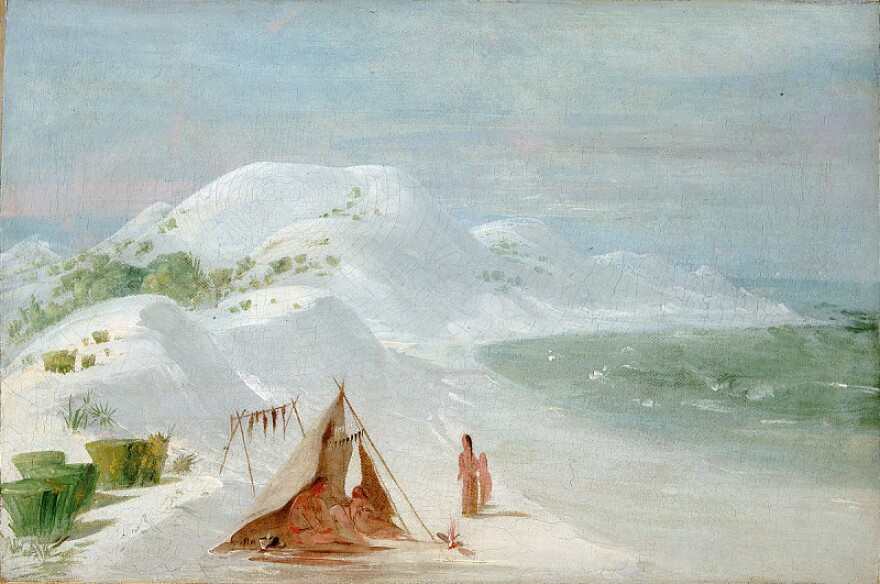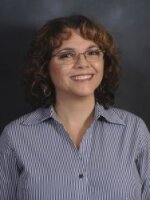Archaeologists are using the latest technology to collect some of the most accurate information to date on location and condition of thousands of cultural heritage sites threatened (in part) by sea level rise. WUWF recently checked in to see how the Florida Public Archaeology Network (FPAN) is deploying laser scanners to determine if it’s an effective way, long-term, to identify those sites that are most endangered and most in need of preservation.
On this windy, overcast day, the FPAN team is working on Pensacola Beach, using a laser scanner to document changes to a possibly pre-historic dune complex.
Before the next round of scans, they climb one of the dunes - behind the trees and bushes - to get out of sight of the scanner.
“You can actually see it’s scanning right now,” said Mike Thomin, a member of the FPAN staff, who also serves as a faculty research associate at the University of West Florida.
“You see, it spinning. It’s shooting lasers out all over the place. We’re good here, we can hide here.”
Today, Thomin, archaeologist Nicole Grinnan and FPAN Director Bill Lees are helping their graduate assistant Jeffery Robinson. The third-year UWF grad student is conducting the laser scanning.
“We’re out at the beach to spend time collecting data on a site that we call ‘Middle Middens,’ so-called because it’s between the dunes,” said Robinson.
“This is an ideal site to test out this device we have called a terrestrial laser scanner (TLS), which allows us to make a 3-D model of the area. If you’re able to take several 3-D models, separated in time, there’s a specific program called “Multi-scale Model to Model Cloud Comparison. And, it allows you to compare the two models to see what’s changed.”
According to Robinson, unless someone comes out and intentionally starts destroying the dune, the only change would be due to erosion.
“Through that, we can get some kind of idea of how fast it’s eroding, like how much dirt has been moved. If we’re lucky, we can even potentially get a volume of how much dirt has been moved.”

Robinson is using a Faro Laser Scanner, applying this fairly new technology at “Middle Middens” to gather data for his Master’s Thesis.
At the root of his research is whether laser scanning can be a good tool for monitoring - over time - the thousands of archaeological sites across the southeast facing a projected rise in sea level and other threats.
“If it is, then maybe we can do this at a bunch of other sites and maybe figure out some sort of triage system,” stated Robinson.
“We can direct resources over here, because this site’s eroding really fast. But, not over here, because this site’s going to be safe for a little while longer. And, that’s the ultimate goal.”
Robinson explains that the laser scanner, placed in the middle of the scan site, is basically Lidar on a tripod. It sends out a repeating laser pulse. An onboard computer measures for when the light gets bounced back. Small white spheres, strategically placed throughout the site, help the software tie together multiple scans.
“So, the laser sweeps over the area and as soon as it hits something, like the ground or something, the light bounces back. The scanner then computes it took like 0.00 seconds to return,” said Robinson, losing his train of thought as his timer goes off.

This means one of the scans has just ended, and it’s time to make adjustments for another round of scanning.
Between scans, Mike Thomin points to the many oyster shells scattered all around.
Also, there's a piece of a sand-tempered clay pot, evidence of Native Americans anywhere from 500-1,000 years ago.

“This is a piece of pre-colonial Native American pottery. It’s what we call a sherd. It’s probably from a broken piece of pot that they discarded here along with the shell that they didn’t need anymore,” Thomin said.
Because the archaeology team is monitoring, and not approved for excavating, this sherd and all the shells will be left in place. And, everything, in minute detail, will be picked up by the laser scanner.
“The first model that we did of this site here at Middle Middens with the laser scanner, we could literally see the footprints in the sand. So, like down to the grain of sand you can see with this.
For pinpoint location information for the laser scans, the FPAN team is also using the latest in satellite GPS technology, explains grad student Robinson, who’s armed with a hand-held Trimble unit.
“This showing us all the different satellites that it’s getting information from, and planes as well. You want to have as many of those as possible to get accurate data.”
Another technology deployed at this Pensacola Beach dune site is photogrammetry, which builds 3D models using a multitude of photographs.
“After we’re done taking the scans, Jeffery will actually go around with an actual digital camera, a decent-quality one, and also take a bunch of photographs,” Thomin explains. “That way we can combine photogrammetry with the 3-D laser scan and get a really cool accurate model.”
After processing, the photos will be layered in to provide a realistic computer image of Middle Middens and all the changes recorded from the previous visit. As Thomin notes, it’s a pretty dynamic site.
“That dune that I’m looking at straight ahead of me, it’s probably six or seven feet tall and it’s got a bunch of vegetation growing on it. Well, it simply wasn’t there, the last time we were out here. It was flat and you could actually see the shell midden and artifacts underneath it.”
The FPAN staff, led by Robinson, are also conducting laser scans at a sites in the Naval Live Oaks Reservation and in the Fort Pickens area. The graduate assistant presented his research at last month’s Southeast Archaeological Conference in Durham, NC.




